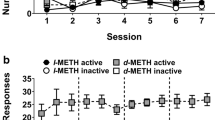Abstract
MDMA (d,1-3,4-Methylenedioxymethamphetamine HCl; “ecstasy”) self-injection (0.1–3.2 mg/kg/injection) was examined in baboons under conditions in which baseline responding was maintained by intravenous injections of cocaine HCl (0.32 mg/kg/injection). Drug was available under a FR 160-response schedule of intravenous injection. Each drug injection was followed by a 3-h time out allowing a maximum of eight injections per day. MDMA or MDMA vehicle (saline) was substituted for cocaine for a period of 14 or more days followed by a return to the cocaine baseline. MDMA (0.32–3.2 mg/kg/inj) maintained more injections and higher responses rates than were maintained by saline. The maximal number of injections maintained by MDMA and the maximal response rate maintained by MDMA were less than those maintained under baseline conditions with cocaine. The highest dose of MDMA tested maintained a cyclic pattern of self-injection, i.e., days of high numbers of injections intermixed with days of low numbers of injections. At the highest dose of MDMA tested, concurrent food maintained behavior was suppressed to an extent that food intake was also decreased.
Similar content being viewed by others
References
Adler J, Abramson P, Katz S, Hager M (1985) Getting high on Ecstasy. Newsweek April 15, p 96
Findley JD, Robinson WW, Peregrino L (1972) Addiction to secobartital and chlordiazepoxide in the rhesus monkey by means of a self-infusion preference precedure. Psychopharmacologia 26:93–144
Glennon RA, Young R, Rosecrans JA, Anderson GM (1982) Discriminative stimulus properties MDA analogs. Biol Psychiatry 17:807–814
Glennon RA, Rosecrans JA, Young R (1983) Drug-induced discrimination: A description of the paradigm and a review of its specific application to the study of hallucinogenic agents. Med Res Rev 3:289–340
Glennon RA, Young R, Hauk AE (1985) Structure-activity studies on methoxy-substituted phenylsopropylamines using drug discrimination methodology. Pharmacol Biochem Behav 22:723–729
Glennon RA, Young R (1984a) Further investigation of the discrimitive stimulus properties of MDA. Pharmacol Biochem Behav 20:501–504
Glennon RA, Young R (1984b) MDA: A psychoactive agent with dual stimulus effects. Life Sci 34:379–383
Greer G (1983) MDMA: A New Psychotropic compound and its effects in humans. 333 Rosario Hill, Santa Fe, N.M. 87501, copyright 1983, pp 1–15
Griffiths RR, Winger G, Brady JV, Snell JD (1976) Comparison of behavior maintained by infusions of eight phenylethylamines in baboons. Psychopharmacology 50:251–258
Griffiths RR, Brady JV, Snell JD (1978) Relationship between anorectic and reinforcing properties of appetite suppressant drugs: Implications for assessment of abuse liability. Biol Psychiatry 13:283–290
Griffiths RR, Brady JV, Bradford LD (1979) Predicting the abuse liability of drugs with animal drug self-administeration procedures: Psychomotor stimulants and Hallucinogens: In: Thompson T, Dews PB (eds) Advances in behaviorial pharmacology, Vol 2. Academic Press, New York, pp 163–208
Harris RA, Snell D, Loh HH (1977) Stereoselective effects of 1-(2,5-demethoxy-4-methylphenyl)-2-aminopropane (DOM) on schedule-controlled behavior. Pharmacol Biochem Behav 7:307–310
Harris RA, Snell D, Loh HH (1978) Effects of d-amphetamine, monomethoxyamphetamines and hallucinogens on schedule-controlled behavior. J Pharmacol Exp Ther 204:103–117
Klein J (1985) The new drug they call “ecstasy”: Is it too much to swallow. New York May 20; pp 38–43
Lukas SE, Griffiths RR, Bradford LD, Brady JV, Daley L, DeLorenzo R (1982) A tethering system for intravenous and intragastric drug administration in the baboon. Pharmacol Biochem Behav 17:823–829
Shafer J (1985) MDMA. Psychedelic drug faces Regulation. Psychology Today May, pp 68–69
Shulgin AT, Nichols DE (1978) Characterization of three new psychotometics. In: Stillman RC, Willette RE (eds) The psychopharmacology of hallucinogens. Pergamon, New York, pp 74–83
Author information
Authors and Affiliations
Rights and permissions
About this article
Cite this article
Lamb, R.J., Griffiths, R.R. Self-injection of d,1-3,4-methylenedioxymethamphetamine (MDMA) in the baboon. Psychopharmacology 91, 268–272 (1987). https://doi.org/10.1007/BF00518175
Received:
Revised:
Issue Date:
DOI: https://doi.org/10.1007/BF00518175




